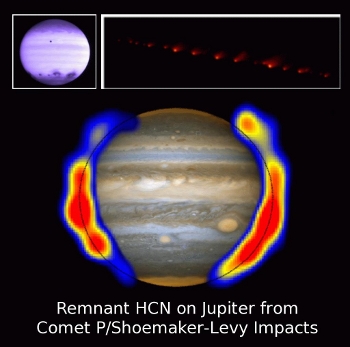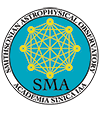 |
|
|
| SMA Research: Remnants of the impact of Comet Shoemaker-Levy still detected in Jupiter's upper atmosphere | ||||
|
In July 1994, comet Shoemaker-Levy 9 (upper right) collided with Jupiter. Over the course of several days multiple impacts deposited material into Jupiter's upper atmosphere near 45 degrees south latitude (upper left). Since the collision, now nearly 15 years ago, molecular trace species from the impacts, such as HCN, CO, and CS, have been detected in the upper atmosphere, and have been slowly fading away. The loss of material has happened faster than expected if only photochemical processes are at work, suggesting that dynamical loss is also involved. In May 2007 we used the SMA to image the distribution of HCN in the Jupiter stratosphere and investigate potential loss from dynamics. Tuning to the HCN(3-2) rotational transition (near 1.1mm wavelength), we obtained a spatial resolution of 5", while Jupiter's angular diameter was 43". The detected HCN emission is displayed as a color intensity map over an optical image of Jupiter (center). The data clearly show peak HCN emission from low northern to mid southern latitudes, and a lack of HCN close to the poles at latitudes > 55 degres. Our map is in good agreement with those obtained in 2000 on HCN at infrared wavelength (Lellouch etal 2006, Griffith etal 2004). The lack of HCN at polar latitudes between 2000 and 2007 indicate a spatial stability which could be due to the presence of a polar vortex, separating the polar stratosphere from the mid-latitudes. In such a case, strong downward transport at the polar vortex edge and in the polar regions of Jupiter' high stratosphere is the main mechanism of the HCN, CS and CO mass loss.
Image Credits:
|

Mark Gurwell (Harvard-Smithsonian CfA), 2009 Click here for a larger view | |||
|
|
